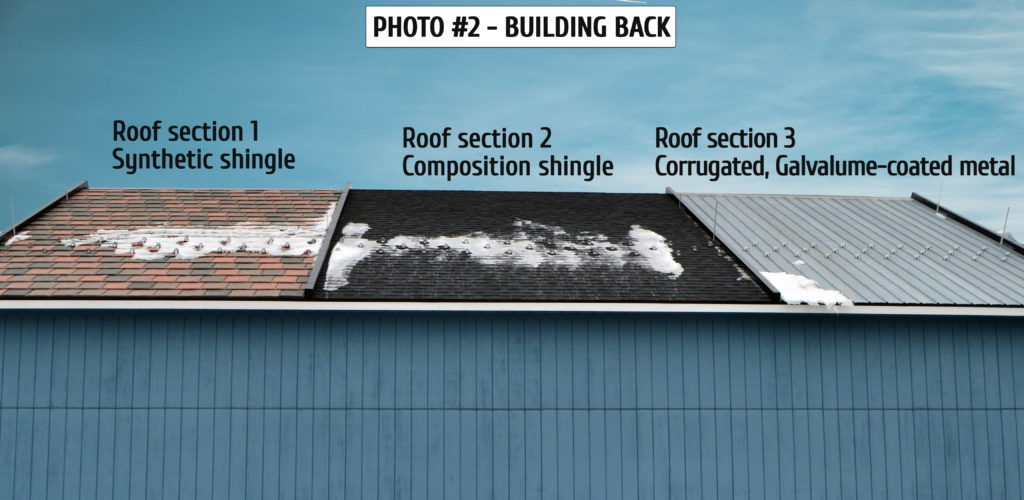As I mentioned in last week’s blog, Alpine SnowGuards constructed an in-house snow guard performance testing facility. It is at our location in Morrisville, VT (10 minutes north of Stowe). We can now accumulate data related to sliding snow conditions on varying roof surfaces.
In-House Snow Guard Performance Testing Facility
The structure as seen above is a salt box configuration with a 12/12 pitch on one side and 14’ rafter length. The other side has a 7/12 pitch and 22’ rafter length.
6 Roof Sections, 3 Different Roof Types, 2 Different Pitches for Data Collection
The 45′ wide roof divides into six 15’ wide roof sections with three on each side. Roof section one is a corrugated, Galvalume-coated metal roof. The middle section is composition shingles, and the third section is covered with synthetic shingles. Each roofing material you see on the front of the building is the same roofing material we installed on the back of the building.

Dividing the roof into sections allows us to observe three different roof types, on two different pitches, simultaneously. In addition, we have constructed a shed roof off the north side gable end of the salt box structure. It is 24’ wide x 12’ rafter length with an 8/12 pitch. This roof is divided into two even sections. The left side is natural slate and the right side is clay tile.

Ledge/Cornice, Solar & Membrane Roof Types, too
The opposite, or south end gable (photo not available), employs a ledge detail associated with high rise structures and cornice covers found on parapet walls associated with many commercial flat roofs. Two separate stand-alone mock-ups are oriented to face the sun. One of these mock-ups has four solar panels mounted to it, while the other is a membrane roof.

We installed roofing materials then added depth gauges along the elevated roof dividing separation detail. You can see those clearly in photo #1 and photo #2. An additional gauge is located along the eaves to measure “snow and ice creep,” also referred to as a cornice.
16 All-Weather Cameras Collect Data 24/7
When the construction details were completed, we added 16 all-weather cameras that collect data on a 24/7 basis. We then linked a weather station to the server, which allows us to monitor temperatures and winds 24/7.
When we were setting up the camera, we didn’t realize that one of them captures the roof of our manufacturing facility. This particular roof is a standing seam metal roof with a 3/12 pitch. We’ve installed snow guards on the driveway side of the building and none on the opposite side. No snow guards are installed on the opposite side. In addition, one camera captures the roof of a neighboring building which has a 4/12 pitch, standing seam metal roof (and no snow guards).

Study & Document Various Snow Management Solutions
The idea is to study and document various snow management solutions, on different roofing materials, with varying roof pitches and varying winter conditions. This can be very different from laboratory-created conditions all at the same time.
Winter conditions are starting to set in, and we’ve already collected great data.
Interestingly, we found an article about a study conducted in Idaho related to sliding snow on various roofing materials. See below – you can purchase this report directly from the ASCE Library, here.
The article references PVC, TPO, EPDM and MB and painted industrial metal profiles. Upon further review, we found many synthetics like PVC and TPO use Polyolefin as a manufacturing component. Characteristics of Polyolefins are shown in this article that describes these materials as slippery with a wax-like surface. Combine these two pieces of information and it would make sense that roofing materials that include P olyolefins will release snow at a 5/12 pitch. Interestingly, this is exactly what our mock up is demonstrating. The 7/12 pitch roof with snow guards installed doesn’t seem to dump in an avalanche fashion.
olyolefins will release snow at a 5/12 pitch. Interestingly, this is exactly what our mock up is demonstrating. The 7/12 pitch roof with snow guards installed doesn’t seem to dump in an avalanche fashion.
So far in our testing, snow guards on the 7/12 pitch with synthetics seem to be adding enough friction to prevent a sudden release of snow. However, the 12/12 pitch roof sheds even before temperatures rise above freezing and before melt water is introduced as a frictionless film between roofing material and snow mass.
Performance Data Leads to New Snow Guard!
We are already documenting performance data on varying roofing materials, roof pitches and snow guard configurations. This has already led to the development of a new snow management solution that we have named Fusion-Guard. The Fusion-Guard system will address many of the snow management issues on steep-slope roofs that have evaded manufacturers for years. It will change the way snow guard installation is practiced!
Fusion-Guard will launch soon and will be the topic of a future blog. In the meantime, watch for video clips as winter allows us to continue with our technical research.
Until then,
Brian Stearns, President & Founder
We keep snow in its place
888.766.4273
Sign up to start using our Online Project Calculator for an immediate layout and project pricing!
Subscribe to our monthly newsletter and keep up on the latest industry and Alpine news, products, and upcoming events!
Alpine SnowGuards designs, engineers, and manufactures snow management systems from our facilities in Morrisville, VT. We work closely with leading roofing contractors, engineering firms, developers, solar installers and roofing manufacturers to ensure we deliver quality products that do what we say they’ll do. Alpine SnowGuards can help a building qualify for LEED® credits.

